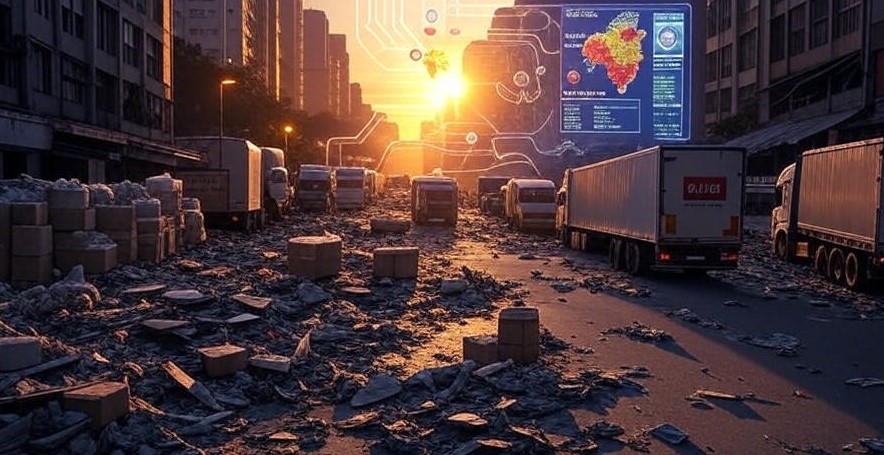Introduction: A Race Against Time
The ground shakes violently as a 7.8-magnitude earthquake tears through a bustling coastal city, toppling buildings and blocking roads with debris. In the chaotic aftermath, humanitarian organizations scramble to deliver food, water, medical supplies, and shelter to thousands of displaced residents. Every moment counts, yet the complexity of coordinating aid in such a crisis—navigating damaged infrastructure, prioritizing urgent needs, and managing limited resources—poses a daunting challenge. Quantum computing, a technology that harnesses the strange laws of quantum mechanics, could soon offer a lifeline. By solving intricate logistical problems with unprecedented speed, it promises to transform how we deliver humanitarian aid in disaster scenarios, potentially saving countless lives. This article explores four key applications—optimizing delivery routes, allocating resources efficiently, analyzing real-time data, and enhancing predictive models—revealing how quantum computing could redefine disaster response.

The Chaos of Disaster Response: Current Challenges
When disaster strikes, the logistics of aid delivery become a high-stakes puzzle. Roads may be impassable, communication networks disrupted, and supplies scarce, while the needs of affected populations vary widely across regions. Classical computing methods, used by organizations like the Red Cross or United Nations, rely on algorithms to plan routes, schedule deliveries, and allocate resources. These systems, however, often struggle with the sheer volume of variables—traffic patterns, road conditions, population densities, and supply availability—that must be processed in real-time. For example, during the 2010 Haiti earthquake, aid delivery was hampered by congested ports and damaged roads, delaying critical supplies to survivors. The urgency of disaster response demands solutions that can adapt dynamically, a task where traditional technology frequently falls short.
The Quantum Advantage: A New Computational Frontier
Quantum computing offers a radical departure from classical methods by leveraging qubits, which can exist in multiple states simultaneously, enabling parallel processing of vast solution spaces. This makes it exceptionally suited for optimization problems, where the goal is to find the best outcome among countless possibilities. In disaster response, where decisions must be made swiftly under pressure, quantum computing’s speed could be transformative. “Quantum computing’s ability to handle complex, multi-variable problems in real-time is a game-changer for emergency management,” notes a 2023 report from Federal News Network. Unlike classical computers, which may take hours to solve large-scale logistics problems, quantum systems could deliver near-optimal solutions in minutes, ensuring aid reaches those in need faster.
Optimizing Delivery Routes: Navigating the Chaos
In a disaster zone, finding the fastest and safest routes for aid delivery vehicles is critical. Damaged bridges, flooded roads, and unpredictable traffic create a logistical nightmare, where every delay can cost lives. Quantum algorithms, such as the Quantum Approximate Optimization Algorithm (QAOA), excel at solving complex routing problems by evaluating multiple paths simultaneously. A notable example is the First Responder Network Design Problem (FRNDP), which focuses on designing efficient networks for responders to reach victims amidst congestion. Researchers, including Anthony Karahalios and Sridhar Tayur, developed GAGA, a hybrid quantum-classical algorithm, tested on scenarios like an anticipated Istanbul earthquake (Quantum Zeitgeist). GAGA quickly identified high-quality routes, demonstrating how quantum computing could guide aid trucks through chaotic environments, ensuring timely deliveries to hospitals or shelters.
Imagine a scenario where a hurricane floods a coastal city, stranding thousands. Aid trucks, loaded with medical supplies, are stuck in gridlock. A quantum computer, fed real-time data on road conditions and traffic, calculates optimal routes in moments, rerouting vehicles to avoid blockages and reach isolated communities. This capability could have transformed responses like that to Hurricane Katrina in 2005, where logistical delays left many without aid for days. By minimizing travel time and maximizing coverage, quantum route optimization could redefine efficiency in crisis situations.

Allocating Resources: Maximizing Impact with Limited Supplies
Disasters often leave humanitarian organizations with limited resources to meet overwhelming demand. Deciding how to distribute food, water, medicine, and shelter across affected areas is a complex combinatorial problem, akin to solving a multidimensional puzzle. Quantum computing can tackle such challenges by optimizing resource allocation, balancing factors like urgency, population size, and transportation constraints. For instance, quantum algorithms can solve variations of the knapsack problem, determining the best way to distribute supplies to maximize impact while staying within capacity limits.
A practical analogy comes from DENSO, a company that used quantum computing to optimize taxi fleet routes, reducing mileage by nearly 10% (Federal News Network). Similar techniques could allocate aid trucks to regions based on need, ensuring that a rural village with critical medical shortages receives priority over a less-affected urban area. In Japan, a quantum-hybrid application optimized nurse scheduling, considering staff specialties and availability, a model that could be adapted for deploying medical teams in disasters (Federal News Network). By ensuring resources are used where they’re most needed, quantum computing could prevent waste and enhance relief efforts’ effectiveness.
Picture a post-earthquake scenario where a relief agency has only 500 medical kits but must serve multiple towns. A quantum algorithm analyzes data on injury rates, population sizes, and transport options, distributing kits to maximize lives saved. This precision could have mitigated shortages during the 2015 Nepal earthquake, where uneven aid distribution left remote areas underserved. Quantum resource allocation offers a path to equitable and efficient aid delivery, turning scarcity into strategic impact.
Real-time Data Analysis: Harnessing the Power of Information
Disaster response thrives on information, from satellite imagery showing flooded areas to social media posts signaling urgent needs. Processing this deluge of data in real-time is a monumental task, often beyond the reach of classical systems. Quantum machine learning (QML) algorithms, which combine quantum computing’s speed with AI’s pattern recognition, could revolutionize this process. A 2024 SpringerLink study highlights QML’s potential to enhance disaster management through real-time data analysis, enabling rapid interventions (SpringerLink).
For example, QML could analyze drone footage to identify passable roads or detect distress signals in social media posts, guiding responders to critical areas. During the 2017 Puerto Rico hurricane response, delayed data processing hindered aid coordination; quantum systems could have accelerated insights, directing supplies to isolated communities faster. QML’s ability to handle vast datasets also supports dynamic updates, adjusting response plans as conditions evolve. Imagine a quantum system sifting through thousands of X posts in seconds, pinpointing a stranded family’s location for immediate rescue. This real-time intelligence could transform how responders navigate the fog of disaster.
Predictive Modeling: Anticipating Needs for Better Response
While the primary focus is on response, quantum computing can enhance predictive models that inform aid delivery strategies. By simulating complex systems with greater accuracy, quantum computers can forecast disaster impacts, such as aftershocks or disease outbreaks, helping responders prepare. A QED-C report notes that quantum computing combined with AI can improve predictions of high-impact weather events, giving responders more time to plan (The Quantum Insider).
In a flood scenario, quantum-enhanced models could predict which areas are likely to be inundated, allowing pre-positioning of supplies. This approach could have bolstered preparations for the 2011 Thailand floods, where delayed forecasts exacerbated losses. By integrating predictive insights with real-time response, quantum computing ensures aid delivery is proactive, not just reactive. “The integration of quantum-enhanced data assimilation marks a significant shift in disaster management,” says a 2024 study (SpringerLink), highlighting its potential to save lives through better planning.
Real-World Examples: Quantum in Action
Quantum computing’s applications in disaster response are already being explored. In Japan, a quantum-hybrid application optimized evacuation routes during tsunamis, managing congestion to ensure safe exits (Federal News Network). This technology could be adapted to guide aid trucks through disaster zones, avoiding bottlenecks. The Australian Army tested quantum-hybrid methods for last-mile resupply, identifying optimal routes for emergency deliveries, a model directly applicable to humanitarian aid (Federal News Network).
NTT is developing applications to establish optimal evacuation routes for disasters like earthquakes, reducing risks from overcrowding (NTT). These routing techniques could streamline aid delivery, ensuring supplies reach shelters efficiently. In another case, quantum computing optimized logistics for missile defense, analyzing 67 million scenarios in 13 seconds, a speed that could translate to rapid aid coordination (Federal News Network). These examples illustrate quantum computing’s growing role in tackling disaster response challenges.
Challenges and the Road Ahead
Despite its promise, quantum computing faces hurdles before it can be widely adopted in disaster response. Current quantum hardware, limited by qubit counts and error rates, cannot yet handle the most complex real-world problems. Hybrid approaches, combining quantum and classical computing, are bridging this gap, as seen in the GAGA algorithm’s success (Quantum Zeitgeist). “We’re still years away from fully practical quantum solutions, but hybrid systems are showing real potential,” notes a 2023 analysis (Inside Quantum Technology).
Integration into disaster response workflows also requires collaboration between quantum scientists, humanitarian experts, and policymakers. Developing user-friendly tools that allow non-experts to leverage quantum computing is essential. Ethical considerations, such as ensuring equitable access to this technology, are equally critical to prevent disparities in disaster response capabilities. Investment in research, as supported by initiatives like the 2024 National Defense Authorization Act’s quantum pilot program (Federal News Network), will drive progress toward practical applications.
Conclusion: A Vision for the Future
Quantum computing stands poised to redefine humanitarian aid delivery, offering tools to navigate the chaos of disaster response with unparalleled efficiency. By optimizing routes, allocating resources, analyzing data in real-time, and enhancing predictive models, it could transform how we save lives in crises. As we stand on the cusp of this technological revolution, fostering collaboration and innovation will be key to turning quantum computing’s promise into reality, ensuring that aid reaches those in need faster and more effectively than ever before.
